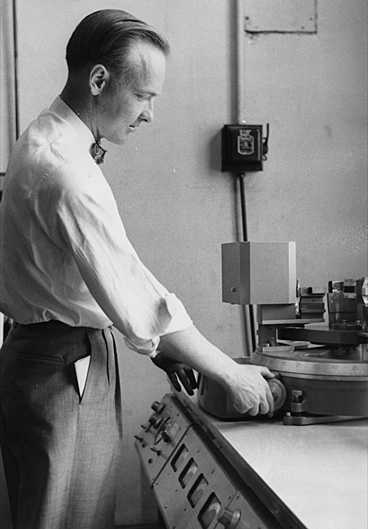Robert E. Ogilvie, professor emeritus of metallurgy in the Department of Materials Science and Engineering, passed away after brief illness on Sept. 3. He was 89.
Ogilvie’s academic foundation in metallurgy and his insatiable curiosity led him to become a world-renowned expert in the detection of art forgeries, the construction of samurai swords, and the analysis of meteorites. His diverse research interests connected him to many communities where he formed strong friendships.
Born in Wallace, Idaho, in 1923, Ogilvie served in the Navy during World War II, and then pursued undergraduate studies at Gonzaga University and the University of Washington. He came to MIT for graduate school in 1950, studying x-ray absorption analysis with Professor John T. Norton. His graduate research led to the development of the electron microbeam probe and the founding of AMR, Inc. with Norton.
Also at that time, he began working with William Young, founder of the Research Lab at the Museum of Fine Arts, Boston, and developed a long collaboration and supportive relationship with what is now the Department of Conservation and Collections Management at the MFA, as well as with conservators and conservation scientists there and elsewhere. He was instrumental in establishing the series of workshops and publications on the Application of Science in the Examination of Works of Art. His use of the electron microprobe in detecting forgeries and authenticating art was the subject of cover stories in Technology Review and Saturday Review.
Another application of the electron microanalyzer was the examination of meteorites; the instrument could determine the objects’ thermal history and the size of the original body of which the meteorite was a fragment. Ogilvie was a member of the Harvard-Smithsonian Meteorite Discussion group, and in 2000 he was recognized for his long-time involvement and contributions with a named minor planet, 3973 Ogilvie.
Ogilvie had a long fascination with the creation and structure of samurai swords, leading him to visit swordmakers in Japan, including the famous Gassan family. His extensive collection of samples and data has been invaluable for students and scholars.
At MIT, he taught “Fundamentals of Crystallography and X-Ray Diffraction,” “Electron Optics,” “Materials Laboratory,” and “Celestial Navigation.” He directed the X-Ray and Electron Optics Lab at MIT and served as president of the Electron Probe Analysis Society of America. An avid sailor, he sailed “Op-Tiki,” a 36-foot Cheoy Lee ketch, around the world with his son Rob.
Ogilvie is survived by children Claudia Ogilvie of Pittsfield, Mass.; Marylee Bergin of Ridgewood, N.J.; and Rob Scott Ogilvie of Nashville, Tenn., as well as grandchildren Robert C. Ogilvie, John G. Ogilvie, Alex Bergin and Zoe Bergin. A memorial will be held at the MIT Chapel on Sept. 28th from 2:00 p.m. to 4:00 p.m. In lieu of flowers, donations may be made to the St. Labre Indian School, 1000 Tongue River Rd., Ashland, MT 59004.
Ogilvie’s academic foundation in metallurgy and his insatiable curiosity led him to become a world-renowned expert in the detection of art forgeries, the construction of samurai swords, and the analysis of meteorites. His diverse research interests connected him to many communities where he formed strong friendships.
Born in Wallace, Idaho, in 1923, Ogilvie served in the Navy during World War II, and then pursued undergraduate studies at Gonzaga University and the University of Washington. He came to MIT for graduate school in 1950, studying x-ray absorption analysis with Professor John T. Norton. His graduate research led to the development of the electron microbeam probe and the founding of AMR, Inc. with Norton.
Also at that time, he began working with William Young, founder of the Research Lab at the Museum of Fine Arts, Boston, and developed a long collaboration and supportive relationship with what is now the Department of Conservation and Collections Management at the MFA, as well as with conservators and conservation scientists there and elsewhere. He was instrumental in establishing the series of workshops and publications on the Application of Science in the Examination of Works of Art. His use of the electron microprobe in detecting forgeries and authenticating art was the subject of cover stories in Technology Review and Saturday Review.
Another application of the electron microanalyzer was the examination of meteorites; the instrument could determine the objects’ thermal history and the size of the original body of which the meteorite was a fragment. Ogilvie was a member of the Harvard-Smithsonian Meteorite Discussion group, and in 2000 he was recognized for his long-time involvement and contributions with a named minor planet, 3973 Ogilvie.
Ogilvie had a long fascination with the creation and structure of samurai swords, leading him to visit swordmakers in Japan, including the famous Gassan family. His extensive collection of samples and data has been invaluable for students and scholars.
At MIT, he taught “Fundamentals of Crystallography and X-Ray Diffraction,” “Electron Optics,” “Materials Laboratory,” and “Celestial Navigation.” He directed the X-Ray and Electron Optics Lab at MIT and served as president of the Electron Probe Analysis Society of America. An avid sailor, he sailed “Op-Tiki,” a 36-foot Cheoy Lee ketch, around the world with his son Rob.
Ogilvie is survived by children Claudia Ogilvie of Pittsfield, Mass.; Marylee Bergin of Ridgewood, N.J.; and Rob Scott Ogilvie of Nashville, Tenn., as well as grandchildren Robert C. Ogilvie, John G. Ogilvie, Alex Bergin and Zoe Bergin. A memorial will be held at the MIT Chapel on Sept. 28th from 2:00 p.m. to 4:00 p.m. In lieu of flowers, donations may be made to the St. Labre Indian School, 1000 Tongue River Rd., Ashland, MT 59004.






